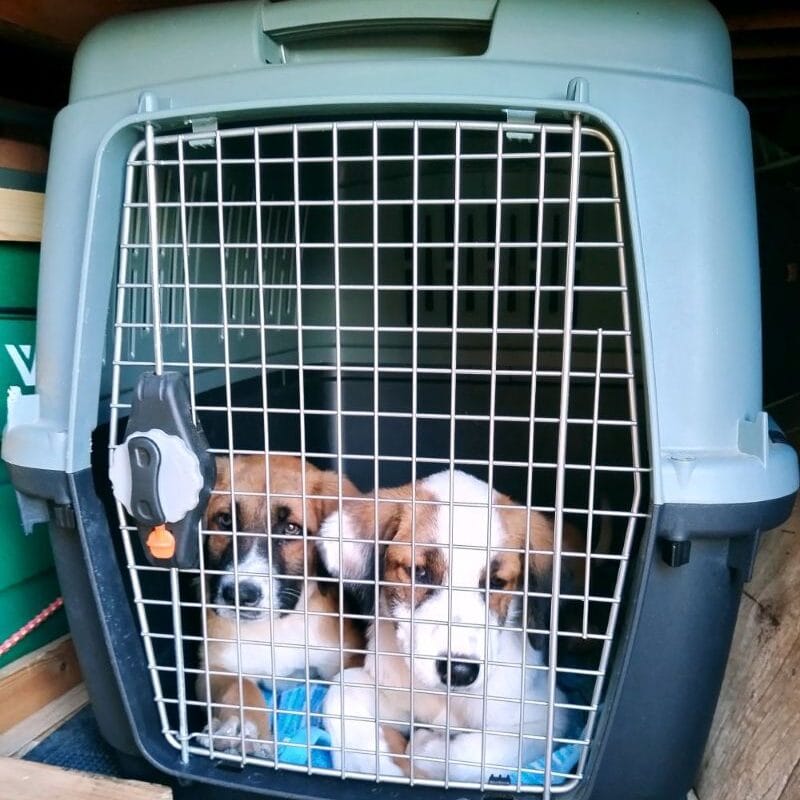Last Updated on 28/11/2025 by Claire Coney
Choosing the best travel crate for your dog can feel like a challenge. You want Fido to be comfortable and safe in the car, plane, ferry or train so that you can have fun adventures together. A good travel crate is essential for this. Unlike regular crates, travel crates should be sturdy, breathable, and easy to carry. They also need to fit Fido’s size and personality.
In this post, I will share some tips on how to choose a travel crate for your dog, based on my experience with my furry friends. I will also explain important factors to think about when choosing a crate, depending on your destination and how you plan to travel
Readers like you support The Fido Trail! If you shop through our links, I might earn a little commission, which helps me create more adventures for Charlie, Ellie, Murphy and Archie and share dog-friendly travel tips. Don’t worry—you won’t pay more. Thanks for your support!
Why a Travel Crate is Essential
Travel crates are not just about convenience—they’re about safety:
- Prevent distractions while driving.
- Meet airline and train carrier requirements.
- Provide a secure and familiar space for your dog.
- Help reduce travel-related anxiety.

What Size Travel Crate is Right for Your Dog?
Choosing the best crate size for your dog is crucial. You want to make sure your furry friend has enough room to stand up, turn around, and lie down comfortably in the crate. But you also don’t want to give Fido too much space, as this can make him feel insecure or tempt him to use the crate as a bathroom. A crate that is too small can also harm Fido’s well-being, as it can cause pain, injury, or stress.
How to Measure Your Dog for a Travel Crate?
To find the right crate size for your dog, you can follow these steps:
Step 1: Measure Your Dog
Before you buy a travel crate, measure Fido’s height, length, and width with a tape measure or ruler. Fido’s height is measured from the floor to the top of his head or ears. His length is the distance from his nose to the base of his tail. His width is measured across his chest or shoulders.
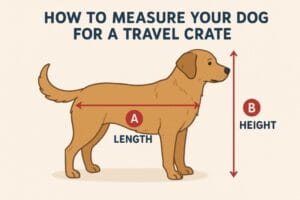
How to Measure Your Puppy for a Travel Crate?
If Fido is a puppy and still growing, choose a crate that will accommodate his adult size—not just his current size. Estimating your pup’s future growth can help avoid buying multiple crates as he matures. Start by identifying your puppy’s breed or breed mix and his current age. This information will give you a general idea of his anticipated adult weight and height. You can use a growth chart or calculator online to predict how big he might get at full maturity.
🐾 Pro Tip: To estimate the adult weight of your dog, try this simple formula (for medium to large breeds):
Adult weight = (Puppy weight at 4 months) × 2.5
Alternatively, consult your veterinarian for a more accurate estimate based on your puppy’s age, breed, and current weight.
When buying atravel crate, choose one that fits your puppy’s projected adult size. If you’re investing in a larger crate now, look for models that come with adjustable divider panels. These allow you to resize the interior space as your puppy grows, providing him with a snug and secure area without the need for frequent upgrades.
🐾 Pro Tip: If you’re using a larger travel crate for your puppy, I recommend making a simple DIY crate divider to adjust the space as they grow. I made mine using and old shoe rack, but you can also use plywood, a thick cutting board, or sturdy cardboard for temporary use. First, cut the divider to fit inside the crate. Then secure it with zip ties or bungee cords through holes in the corners. It really helped with potty training and kept my puppies from feeling overwhelmed in too much space. Plus, it saved me buying multiple crates as they got bigger!
Step 2: Compare Your Dog’s Measurements To The Travel Crate Dimensions.
You can find the dimensions of the travel crate in the product description or on the label.
Alternatively, refer to a crate size chart that corresponds to your dog’s breed and weight. Ideally, the travel crate should be 2 to 4 inches longer and taller than your dog and slightly wider as well.
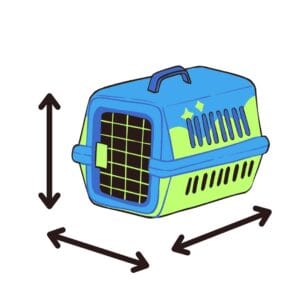
If possible, try out the crate before making a purchase. Bring your dog to the store and let them enter the crate. They should be able to stand up, turn around, and lie down comfortably. If not, consider selecting a different size.
Size and Breed Compatibility
Some Travel crates work better for certain dog sizes. Here’s a quick guide:
| Dog Size | Crate Size | Recommended Crate |
| Small (Chihuahua) | 19–22” | Moderna Odyssey Dog Carrier |
| Medium (Cocker Spaniel) | 28–30” | Ferplast Atlas Scenic Car Transport Box |
| Large (Labrador) | 36–42” | Trixie Light Grey/Dark Grey Transport Box Gulliver |
| Extra Large (Greman Shepard) | 48”+ | AluRide Dog Crate for Extra Large Dogs |
What Is The Difference Between A Dog Travel Crate And A Carrier?
The primary difference between a dog travel crate and a carrier lies in their size and construction. Travel crates are generally more robust and larger. Carriers, on the other hand, are typically smaller. They are soft-sided and designed for carrying smaller dogs. It’s important to choose the right type based on the size of the dog and the mode of transport.
What Type of Material is Best for a Dog Travel Crate?
The material of the travel crate affects its durability, weight, and comfort. Here are the most common types:
Fabric Soft-Sided Travel Crates
Fabric travel crates are lightweight, cosy, and portable. They are great for small dogs and short trips. Lightweight and easy to store. However, they are not suitable for dogs who like to chew or scratch.
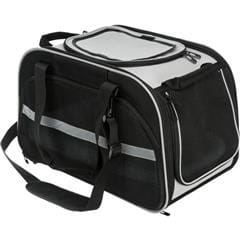
Plastic (Hard-Sided) Travel Crates
Plastic travel crates are sturdy, easy to clean, and provide insulation. They are Ideal for flights and long road trips. Durable and airline-approved.
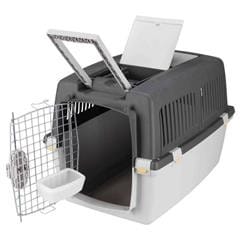
Metal Wire Travel Crates
Metal travel crates are durable, and ventilated, and allow you to see Fido. Suitable for crate-trained dogs during car travel, not for flying.
- Best Pick: Trixie Aluminium Dog Crate
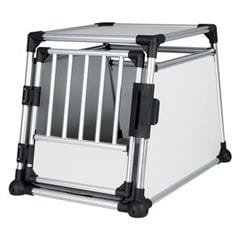
What Shape Should Your Dog’s Travel Crate Be?
Different travel plans require different crate shapes. Some crates can fold or collapse to save space and make them easier to carry.
Dog Crates For Air Travel
You will need a crate that meets the airline’s requirements and fits under the seat or in the cargo area. Look for IATA-compliant crates (airline-approved). Hard-sided crates with secure latches are a must. Check your airline’s pet travel policy.
Dog Crates For Car Travel
You will need a crate that fits in your vehicle and does not obstruct your view or interfere with your driving.
Dog Carries For Train or Bus
Soft-sided carriers may be required, so it’s important to check each company’s pet policy. I particularly like the Kurgo K9 Rucksack for my Cairn Terrier, Abigail. It’s easy to pop her inside, leaving my hands free to carry my own luggage. It’s also great for hiking!

Dog Travel Crate Ventilation
Ventilation on multiple sides. The crate should have enough ventilation holes or mesh panels to allow air circulation and prevent overheating. This is especially important for hot climates or long trips. Ventilation also helps your dog see outside and feel less anxious. For example, Ellie tends to worry and cry when she can’t see us.
Should Dogs Share Travel Crates?
I wouldn’t recommend having dogs share a travel crate on long journeys. Sharing a crate can cause anxiety, aggression, overheating, and injury for dogs, especially if they are not used to being confined together. Moreover, some airlines and other transport services have strict regulations that prohibit dogs from sharing a crate. However, there are exception when my two Greek rescue puppies, Murphy and Archie, came along, they were scared and dependent on each other, so I decided to crate them together. They are much happier when travelling in our van together.

Safety Requirements for Dog Travel Crates
The travel crate should have a secure latch or zipper that prevents Fido from escaping or getting injured. It should also have smooth edges and corners that do not pose a choking or cutting hazard. Removable pads or cushions. Carrying handles or wheels for portability. Ensure your dog’s travel crate is secure and stable. If you are travelling by car the crate should be strapped in to prevent it moving during the journey. Avoid placing the crate near sharp or hot objects or in direct sunlight.
Additionally, you should check the crate for any signs of damage or wear before each use. No matter what carrier you choose, it should be easy to assemble, store, and use. Otherwise, you will be less likely to use it.
🐾 Pro Tip: To make the crate feel more like home, add a familiar travel crate mat or toy inside. For example, Ellie, my German Shepherd, loves her comfy cushion and happily snoozes in her travel crate. She even chooses to sleep inside it when the door is left open for her.
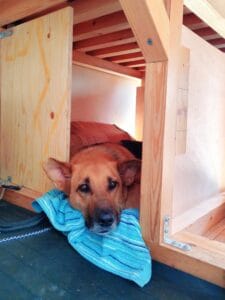
How To Train A Dog To Travel In A Dog Crate?
Training a dog to travel in a crate involves creating a positive association with the crate.
I begin by introducing my dogs to the crate at home without forcing them inside. To encourage exploration and comfort, I place treats and toys inside and gradually increase the amount of time they spend in the crate with the door closed.
I usually start crate training during the puppy stage, but Abigail and Ellie were adult dogs when I started the process with them. Through consistency and patience, they learned that their crate was a safe and comfortable space. I rewarded their calm behaviour with treats, and they adapted quickly to their travel crates.
Brands of Travel Dog Crates
There are many brands of travel crates available on the market, but not all of them are equally reliable or suitable for your dog. Some of the most popular and trusted brands are Trixie, Aluline, Feria and Ferplas. You can read customer reviews, compare prices, and check the features of each brand before making a purchase.

Wrapping It Up
You have learnt a lot about how to choose and use a travel crate for your dog. Here are some main points to remember:
- A travel crate is more than just a container for your dog. It’s a place where they can feel safe, comfortable, and relaxed.
- The size, shape, material, and travel crate design should match your dog’s needs and preferences.
- Measure your dog and compare it to the crate dimensions before buying one.
- Consider your dog’s personality, age, health, and travel habits when choosing a travel crate. Some dogs may need more ventilation, padding, visibility, or security than others.
- Make your dog’s travel crate a cosy and fun place. Add water, toys, treats, and familiar items. Do not forget to check on your dog regularly and offer them water.
- Always make sure your dog’s travel crate is secure and stable. Avoid placing it near sharp or hot objects or in direct sunlight.
With these tips, you can find the perfect travel crate for your dog and have a great time together on your next adventure.
Now I am curious:
Where did you and your dog go? And what kind of travel crate did you use?
Do you have questions or favourite crates? Leave a comment below or tag us on Instagram @TheFidoTrail.
(And if you want more tips on how to travel in a car with your dog, check out this article.)
Travelling in a car with your dog.


